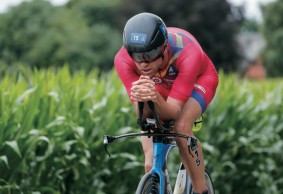Reverse periodisation - what is it? how does it work?
Top triathletes using reverse periodisation. Team Ineos Grenadiers implementing reverse periodisation. Many personal trainers prescribing reverse periodisation. But what the hell is reverse periodisation and what is it for?

What is reverse periodisation?
If you don't know what reverse periodisation is, your head may explode after reading these first paragraphs. Because it is the upside-down world as you know it.
Let's start from the fact that the planning of training, of a season, scheduled, calendarised, has been for decades based on a basic premise: in the first phase, we do all the hard work, we get in shape, we dedicate ourselves to the end. The famous "creating a base" on which we can then improve, refine and perfectionise.
RECOMENDADO

How to wash your cycling clothes? 10 keys to make them always look new

How to change the pedals of any bike in 5 steps

This is how they erase the penises that are drawn on the roads of the Tour de France

How to lose body fat? Differences between losing weight and losing fat

When must the tubeless tire sealant be replaced? What quantity?

Free alternatives to Zwift

After this base, and already in the middle of the season, the future peaks of fitness are planned, and training is carried out in short intervals and at high intensity in order to reach these peaks on the estimated dates.
In short: first the endurance, then the rest. Right? Well... no, reverse periodisation proposes just the opposite: first high intensity in very short training sessions, and then endurance training in the middle of the season. We will explain why.

Why turn your training plan around with reverse periodisation?
Because the main risk of a traditional method has a name: overtraining. Fatigue, injuries. That's right, these are the most notable consequences of this planning. And for this reason, it became clear to many training analysts that turning the traditional method upside down could have great benefits.

And so it is. Reverse periodisation has been confirmed as the ideal training method to prevent all these risks in the middle of the season. It reduces the risk of injury as well as the risk of a breakdown.
Of course, it has its drawbacks and conditions. Training with reverse periodisation requires something fundamental: to be in shape. It sounds contradictory but let's say that reverse periodisation is not designed for beginners. It requires that, although out of peak form, the athlete has a constant aerobic base that has been well worked on for years. A base that prevents that with the first high intensity training sessions the athlete does not suffer at all, any system: neither the motor, nor the nervous, nor the respiratory, nor the circulatory.

But its advantages, as we say, are compensated for these athletes, above all because they reduce a first phase that often lasts for weeks. This concept of "getting in shape" requires a lot of rides and rides and accumulating kilometres without much more sense. And that's something you save from the start. There is already time during the season to spread those kilometres over training sessions that are more demanding in preparation for a competition. In addition, the reverse periodisation makes your training sessions close to the competition a lot more similar to what you are going to find in the race, and not the other way round.

Basically, reverse periodisation is structured in a first phase, in which you will work on strength, power, speed and reaction; and a second phase, in which you will start to focus on endurance for the beginning of the season. Later, during the season, the model changes: both training sessions are combined to achieve a reverse periodisation table.
So, you know, in this century when everything is called into question, even the traditional training method is in trouble, and reverse periodisation is the same with respect to those schedules and those seasonal plans.